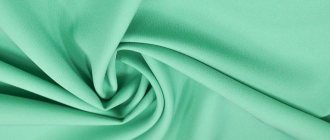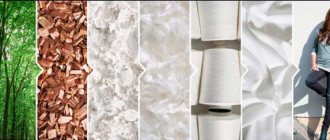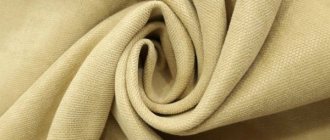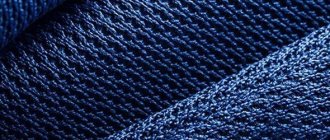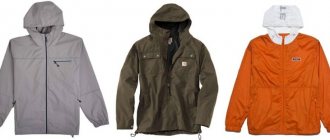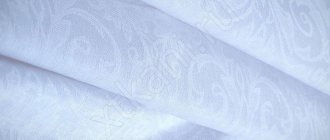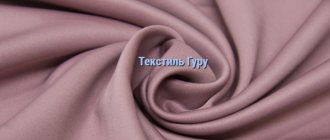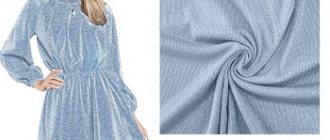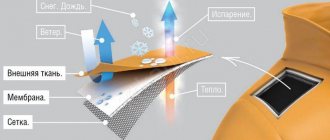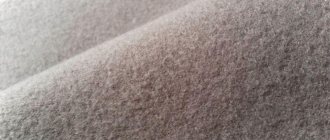In this article we will give a description of crepe de Chine fabric, talk about its properties with photos, advantages, disadvantages and use in clothing. Crepe de Chine is a type of crepe fabric produced by twisting the threads as tightly as possible. Translated from Chinese, this word is translated as “Chinese crepe” or “Chinese silk”, since silk fibers are the basis of the weave. This is one of the most common fabrics in the vastness of the USSR, products from which were present in every woman’s wardrobe.
Origin story
In the past, only Chinese emperors and their entourage wore silk clothes.
The secret of sericulture was kept in the strictest confidence. But everything secret becomes clear at some point, and the Japanese, and then the Arabs, began to breed silkworms. The Crusades brought the secrets of silk production to Western Europe, in particular to the Italian lands. And in the Middle Ages, when spinning workshops appeared, the Italians and French established a successful trade in silk.
By the way, Italy still remains the largest producer of natural silk in Europe, incl. crepe de Chine, and in the world, of course, China.
How to care
Although fabric made from natural silk threads is durable, it still requires competent and careful care. If the fabric contains weaves of other fibers (wool, cotton, synthetics), then its care should take into account the characteristics of these materials. Basic information is always indicated on the label.
How to properly care for natural crepe de Chine:
- Wash products either by hand or in a machine, choosing a mode for delicate fabrics.
- Soft gels are used for washing, as powder and soap can reduce the brightness of the color.
- The product is dried away from sources of heat and light. Exposure to sunlight or radiators causes the fabric to become dry and brittle.
- You need to iron a crepe de Chine product from the wrong side.
- The fabric is stored in special cases into which air flows.
This is basic information about crepe de chine fabric. Products made from light flowing material easily create a romantic image and are rightfully considered an indicator of the femininity of the owner.
Composition of crepe de Chine and its properties
Crepe de Chine is a light flowing fabric with a rough surface and a matte sheen. The basis of the material is silk threads. Sometimes, in order to reduce cost, increase strength and wear resistance, threads of cotton, wool, elastane, and acetate are woven. The main feature of crepe de Chine, which distinguishes it favorably from other silk fabrics, is its low creaseability.
Crepe de Chine is often confused with chiffon, also a silk fabric. But, “Chinese crepe” is less transparent than chiffon.
Crepe chiffon
Definition, review and description of crepe chiffon fabric
more details
Crepe de Chine fabric: where is it used?
The unique properties of the fabric completely determine its scope of application. Crepe de Chine fabric is widely used in the manufacture of all types of women's clothing. Beautiful blouses, jackets, skirts, suits and dresses are made from this material. In our “Clothing Fabrics” section you can find information about all types of materials. Silk crepe de Chine drapes well, forming soft, round folds. Its rough texture is ideal for hand-painted batik. This technique is used to produce scarves and shawls with interesting designs.
Practical and durable woven fabric makes beautiful curtains, bed linen and other types of home textiles.
Types of crepe de Chine
The following division is accepted in the textile industry:
- Natural or classic - the most expensive material, consists exclusively of silk threads. Elegant dresses and blouses are made from it.
- Wool is 100% natural, but the addition of wool threads makes crepe de Chine denser. He goes to sewing suits and shirts.
- Blended - with a large proportion of vegetable threads - cotton, linen, viscose.
- Synthetic - consisting of artificial threads, mainly polyester. Outwardly, it is almost no different from natural silk, but there is no warmth inherent in real silk.
Types of crepe de Chine
Advantages and disadvantages
Pros:
- pleasant to the touch, soft, light, comfortable material;
- thanks to the special weave of the threads, it practically does not wrinkle;
- hygroscopic, breathable, hypoallergenic material;
- does not shine through, despite its lightness and airiness;
- colors do not fade or fade and can withstand numerous washes;
- With proper handling, it does not lose its presentation for years, maintaining its original beauty.
And now the disadvantages:
- the fabric is thin, delicate, prone to shrinkage, and needs to be treated with care: proper washing, drying and ironing;
- the material is “movable”, this creates certain inconveniences when working with it;
- high cost: not every woman can afford natural crepe de Chine.
Description
Crepe de Chine is a type of crepe fabric that is produced by tightly twisting the threads. The name of the material is literally translated from French as “Chinese silk”. It is the silk threads in the warp, intertwined with the crepe twisted threads in the weft, that form the crepe de Chine material. It can be described as flowing, granular, with a wavy surface. However, the fabric does not have a silky sheen.
The roughness is explained by a certain alternation of twisted warp and weft threads. This achieves high strength and density of the material. To create fabric, not only silk threads are often used, but also cotton, wool, linen and even synthetic ones. Real crepe de Chine is a flowing lightweight fabric that is pleasant to the body.
Matter has many positive properties, otherwise it would never have reached the peak of popularity.
Here are the main ones:
- Ease. 1 square meter of crepe de Chine weighs about 60 grams.
- Breathability. The fabric allows the skin to breathe, which is why summer clothes are made from it. It won't be hot in such material.
- Real fabric does not wrinkle. This is the main property that allows you to distinguish a fake from the original.
- The material is easy to wash and dries quickly.
- Durability is one of the hallmarks of a good crepe de Chine. Products made from it do not fade in the sun.
- Thanks to the special weave of the threads, this fabric has increased strength.
- The material drapes well, forming soft and neat folds.
Advice! Crumple the textile product in your fist - if folds and kinks form, then this is a different material that is passed off as Chinese silk.
What kind of clothes are made from crepe de Chine?
The properties of the material make it possible to sew from it not only blouses and dresses, but also suits. For suit sets there is heavy, high-density crepe de chine. The fabric drapes perfectly and holds its shape, which makes it possible to beautifully fit the item on any figure.
- blouses look very elegant. They can be with long or short sleeves. For plump ladies, the option gathered at the bottom is suitable. The blouse can be made in the form of a shirt or tunic of different lengths, have a plain, calm, or bright design.
- Long evening dresses made of crepe de Chine are ideal for special occasions. Couturiers sew them with a wide flying hem or train.
- Short models are worn at any time of the year for various occasions. These can be sundresses, tunic dresses, options with a flared hem and an open back, A-line dresses, wrap models, straight universal dresses for all occasions.
- Skirts . They can be plain or with a printed pattern, of different lengths and styles. For young people, short and fluffy “tutu” style skirts are suitable; for women of an elegant age, long and flowing floor-length skirts with a “sun” silhouette are suitable.
- All kinds of scarves and shawls . Without them, it is difficult to imagine the complete image of a stylish and fashionable lady. They are worn on the head and neck, draped over the shoulders, and tied around the waist. You can even make an elegant top from such a large scarf. It is suitable for a romantic look and complements a set of clothes in a classic style.
- Pareos are indispensable for a beach holiday. They can easily be turned into a tunic, sundress and skirt, going, for example, to a coastal cafe. A pareo thrown over your shoulders will prevent you from getting sunburned and will help hide any flaws in your figure, if any.
Fabric Features
Matte thin and light fabric - crepe de chine - came to us from France at the end of the 19th century. They say that it was brought there from China itself, hence the name, Crepe de Chine - crepe from China. It’s impossible to say for sure; history has been forgotten.
But everyone remembers very well the beginning of the 20th century, especially the 20s, and the sheer popularity of crepe. In those years when Vera Kholodnaya’s fingers smelled of incense, it is very likely that her shoulders under her boa were decorated with crepe de Chine. Pale shades were in trend back then; the era of decadence dictated its own rules.
Ballerinas and suffragettes, ladies of the demimonde and hostesses of secular salons, they were united by crepe de Chine outfits. True, they differed in cut.
Fortunately, crepe is universal: it drapes exquisitely even in the most intricate silhouettes with multi-layered ruffles and lies elegantly in a simple A-line cut.
Crepe de Chine is a fabric that does not go well with war and hardship, so its popularity depends on the peace in society. She was forgotten in difficult years, but in periods of peace, when women wore flowers, thought about love and dreamed, she again returned to wardrobes and into the orbit of designers’ interests.
Despite the truly rich history, the description of crepe de Chine fabric must begin with almost mystical tactile sensations: a light rough surface, slightly cool, but adapting to the warmth of the palm. Delicate, but not smooth - luxurious, caressing the skin, but without the excess oiliness characteristic of satin silk.
Tips for choosing
A dress made of silk crepe de Chine is not a tribute to fashion trends, but a smart investment, because with proper care the material not only does not age, it does not become obsolete. If you buy something with a classic cut from a well-known brand, it can be worn decades later, but as an exquisite vintage element of an expensive look.
However, to avoid buying a fake, you need to carefully check the fabric before purchasing.
Real silk crepe does not wrinkle even with strong compression; it wraps pleasantly around the wrist, but does not warm. If you rub it, it does not crunch or become electrified.
If you need to buy a cut from a roll, checking the quality is even easier. You need to pull out the thread, set it on fire, then analyze the burnt edge:
- burnt silk smells unpleasantly of burnt hair or feathers, burns slowly, tends to go out, and rolls into a fragile lump;
- viscose burns quickly, like paper, it smells like paper, burns to ashes;
- synthetic fabrics do not burn, but melt and roll into a strong teardrop.
In addition, the seller must have a certificate of conformity. From the documents, among other things, you can find out the country of origin and the density of the material.
Silk or synthetic?
It is not difficult to distinguish artificial crepe de Chine from natural one. First of all, you should trust your sense of touch. If you cover your hand with natural silk, you will feel a sense of comfort; after a while, adding synthetics will create a feeling of a “thermos” on the skin. It is somewhat more difficult to detect the addition of viscose. To do this, you need to crumple a corner of the fabric - the bends in natural crepe de Chine quickly straighten out. Finally, the most accurate way to determine the composition is the burning behavior of the fibers. A thread of natural silk burns rather slowly, its charred end crumbles, and the smell of burnt feathers appears. Viscose flares up instantly and smells like burnt paper. But the synthetic melts into a characteristic hard ball at the end of the thread.
How to sew something from crepe de Chine
Experienced dressmakers advise those who are new to sewing silk dresses to choose models with as few seams as possible. Complex cutting can only be done by professionals, since silk fabrics behave insidiously when sewing. The fabric, pressed by the foot of the sewing machine, slides and moves, as a result it begins to fold.
It is advisable that the seams run along the longitudinal rather than transverse thread, then there will be fewer problems with sewing. Since this fabric is thin and delicate, it does not like rough processing. For example, if you don’t have an overlog, you won’t be able to finish the edge with a zigzag seam; the material will bunch up and look like a hard roller.
The style of crepe de Chine dresses must have room for a loose fit, otherwise the seams of the product will unravel from strong tension. The seams need to be double and thin. It is best to choose flowing and loose models of skirts and dresses for sewing.
Compound
Traditionally, crepe de Chine was made exclusively from raw silk - not the most expensive raw material, but rather a waste product. Nowadays, its production uses mainly purified buret silk, which is combed and saved for satin weaving.
Blends of silk and wool never became popular among consumers, but many people liked modern analogues based on artificial and synthetic fibers.
For crepe de Chine, fibers are used that are as close in appearance to silk as possible - viscose and acetates. An economical option is a polyester crepe, which resembles the original only in appearance, and only from afar.
Scope of application of crepe de chine materials
The material is used primarily for sewing beautiful, elegant women's clothing: formal skirts, blouses, dresses, including wedding ones. Things made from it hide figure flaws, giving the image femininity and romance. Products made from these fabrics are appropriate not only for a summer walk, but also in an official setting.
In addition, crepe de Chine is used to make home textiles: bedroom canopies, curtains, curtains, bedspreads. It is also very suitable for various accessories: scarves, capes, stoles.
Manufacturing
The technique of making crepe or printed silk is believed to be very old - although it is constantly being modernized. To make crepe de chine, the threads of the raw material are twisted strongly in opposite directions (the so-called crepe twist). The plain weave of the threads is complemented by elements of “stuffing” when the weft moves with additional force. This, on the one hand, increases the tensile strength of the fabric, and on the other, gives it tactile playfulness and roughness. Just because of the density of the material, it will flow and not curl up and stick to your feet.
The resulting texture of the front surface is the hallmark of crepe de Chine. Modern technologies make it possible to use other fibers, not just silk, but the point is in twisting.
Advantages and disadvantages
Crepe de Chine is silk, but a special one. Firstly, it is practically devoid of the main drawback of the silkworm product - wrinkleability, although it is still very difficult to care for. Secondly, it is expensive and often counterfeited. True, it’s enough to hold it in your hands, all the shortcomings are somehow leveled out.
Author:
Anastasia Kukushkina
I hope you enjoy the article I have prepared for you! If you find errors in it, write to me about it! I will answer any questions you have, ask them!
